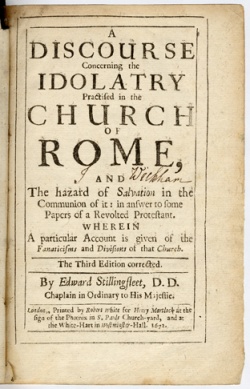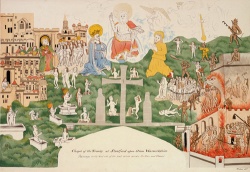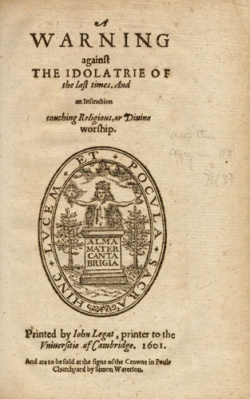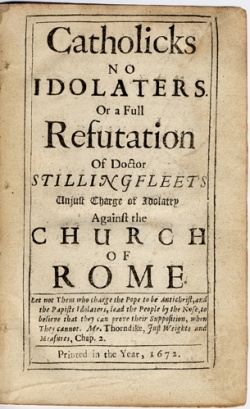Idolatry: Icons and Iconoclasm: Difference between revisions
MeaghanBrown (talk | contribs) mNo edit summary |
MeaghanBrown (talk | contribs) mNo edit summary |
||
| Line 1: | Line 1: | ||
This article was written by Carlos R. Piar (California State University, Long Beach) as part of the Sites of Cultural Stress from Reformation to Revolution Summer 2003 NEH Institute directed by [[David Cressy]] and [[Lori Anne Ferrell]]. For more past programming from the [[Folger Institute]], please see the article [[Folger Institute scholarly programs archive]]. | This article was written by Carlos R. Piar (California State University, Long Beach) as part of the Sites of Cultural Stress from Reformation to Revolution Summer 2003 NEH Institute directed by [[David Cressy]] and [[Lori Anne Ferrell]]. For more past programming from the [[Folger Institute]], please see the article [[Folger Institute scholarly programs archive]]. | ||
== Idolatry: Icons and Iconoclasm == | == Idolatry: Icons and Iconoclasm == | ||
| Line 17: | Line 15: | ||
[[File:Godden Catholics No Idolaters.jpg|250px|left|thumb| Thomas Godden (1624-1688), ''Catholicks no idolaters. Or a full refutation of Doctor Stillingfleet's unjust charge of idolatry against the Church of Rome'' [London: s.n.], 1672. Wing G918, title page.]]The controversy, over the years, gave rise to a plethora of theological tracts, some supporting and others opposing the use of images in worship. One example of the latter is the Puritan divine William Perkins' ''A Warning Against the Idolatrie of the Last Times''. In this influential tract, Perkins argues that monuments (as on tombs) are not idols, but that when images are used to represent God or when what is proper to God is ascribed to creatures or things, idolatry is committed. But Perkins goes further in arguing that misconceptions of God, mental images, pose a danger of idolatry and so the mind must be purged of these as well. | [[File:Godden Catholics No Idolaters.jpg|250px|left|thumb| Thomas Godden (1624-1688), ''Catholicks no idolaters. Or a full refutation of Doctor Stillingfleet's unjust charge of idolatry against the Church of Rome'' [London: s.n.], 1672. Wing G918, title page.]]The controversy, over the years, gave rise to a plethora of theological tracts, some supporting and others opposing the use of images in worship. One example of the latter is the Puritan divine William Perkins' ''A Warning Against the Idolatrie of the Last Times''. In this influential tract, Perkins argues that monuments (as on tombs) are not idols, but that when images are used to represent God or when what is proper to God is ascribed to creatures or things, idolatry is committed. But Perkins goes further in arguing that misconceptions of God, mental images, pose a danger of idolatry and so the mind must be purged of these as well. | ||
The controversies over the use of images in worship erupted again in the late seventeenth century, during a period of increasing anti-Catholic hysteria. The laws established by Parliament in the Restoration, such as the Clarendon Code (1661–66), which put restrictions on dissenters, and the Test Act (1673), which required civil servants to denounce transubstantiation and swear allegiance to the Church of England, equated Catholics with dissenters. The conversion of James, Duke of York and heir to the throne, to Catholicism only heightened fears of a resurgent Catholicism. The "Popish plot" (1678) revealed by Titus Oates may have been the climax of the anti-Catholicism of this period in English history. It was in this environment that Thomas Godden, Catholic convert from Protestantism, authored'' Catholicks No Idolaters, or a Full Refutation of Doctor Stillingfleet's Unjust Charge of Idolatry Against the Church of Rome (''1672). Here Godden defends the use of images from the attacks of Bishop Edward Stillingfleet, who had written a treatise titled ''A Discourse Concerning the Idolatry Practiced in the Church of Rome and the Danger of Salvation in the Communion of It.'' | [[File:Stillingfleet Discourse Concerning the Idolatry.jpg|250px|right|thumb| Edward Stillingfleet (1635-1699), ''A discourse concerning the idolatry practised in the Church of Rome, and the hazard of salvation in the communion of it: in answer to some papers of a revolted Protestant'' London: printed by Robert White for Henry Mortlock at the sign of the Phoenix in S. Pauls Church-yard, and at the White-Hart in Westminster-Hall, 1672. Wing S5579, title page.]]The controversies over the use of images in worship erupted again in the late seventeenth century, during a period of increasing anti-Catholic hysteria. The laws established by Parliament in the Restoration, such as the Clarendon Code (1661–66), which put restrictions on dissenters, and the Test Act (1673), which required civil servants to denounce transubstantiation and swear allegiance to the Church of England, equated Catholics with dissenters. The conversion of James, Duke of York and heir to the throne, to Catholicism only heightened fears of a resurgent Catholicism. The "Popish plot" (1678) revealed by Titus Oates may have been the climax of the anti-Catholicism of this period in English history. It was in this environment that Thomas Godden, Catholic convert from Protestantism, authored'' Catholicks No Idolaters, or a Full Refutation of Doctor Stillingfleet's Unjust Charge of Idolatry Against the Church of Rome (''1672). Here Godden defends the use of images from the attacks of Bishop Edward Stillingfleet, who had written a treatise titled ''A Discourse Concerning the Idolatry Practiced in the Church of Rome and the Danger of Salvation in the Communion of It.'' While Stillingfleet is generally considered a Latitudinarian—a seventeenth-century clergyman who adopted more liberal notions in respect to the authority, government, and doctrines of the church than generally prevailed—his toleration of dissent did not extend to Roman Catholicism and the use of images. Stillingfleet's treatise and Godden's response are evidence of the insistent Protestant association of idolatry with Popery, a connection that continued to be made well into the seventeenth century. | ||
Carlos R. Piar | Carlos R. Piar | ||
Revision as of 08:49, 16 March 2015
This article was written by Carlos R. Piar (California State University, Long Beach) as part of the Sites of Cultural Stress from Reformation to Revolution Summer 2003 NEH Institute directed by David Cressy and Lori Anne Ferrell. For more past programming from the Folger Institute, please see the article Folger Institute scholarly programs archive.
Idolatry: Icons and Iconoclasm
The Church of England was torn asunder over disputes concerning polity, the meaning of the Eucharist, and liturgy. Another important issue of tension was the role of images in worship. The Protestant Reformation spurred a revival of iconoclasm, or the destruction of images as idolatrous. In eighth-century Byzantium, the use of images in worship had been condemned by Emperor Leo III (who reigned 717–741), who in turn was condemned by Pope Gregory III (who reigned 731–741) as a heretic. The Second Council of Nicea (787) settled the iconoclastic controversy by establishing a distinction between worship (latria—due to God alone) and veneration (dulia—offered to saints and images). Subsequently, the use of images in both the Eastern and Western churches continued unabated until the Protestant Reformation, when a rejection of tradition in favor of Scriptural literalism resulted in the rejection of the veneration of images as idolatry on the grounds that it was a clear violation of the second Commandment: "Thou shall have no other gods before me" (Exod. 20:4–6).
The conflict over idolatry, which began on the Continent with Luther and Calvin's polemics against Rome, eventually crossed the Channel into England with Henry VIII's break with Rome. Protestant sympathizers translated and published iconoclastic works such as John Ryckes' Image of Love (1525) and John Calvin's sermons. Opponents published their own counterarguments; Thomas More, for example, refuted Ryckes' Image of Love in his Dialogue Concerning Tyndale (1529). The main argument of the defenders was that images were "laymen's books" enabling the illiterate peasantry to acquire knowledge of the Christian faith and grow spiritually. Images of Christ and the saints, the argument went, were not objects of worship, but didactic aids. As Protestant ideas spread and took hold, however, the tensions over the use of images, and whether such use constituted idolatry, became more intense. Thomas Cranmer and Hugh Latimer preached against them. Nicholas Ridley attacked idolatry in A Treatise on the Worship of Images.
Following the accession of Edward VI, royal injunctions ordered the removal of all images from English churches in 1548. Iconoclasm reached a fevered pitch during Edward's reign, resulting in the defacement of baptismal fonts, the destruction of stained glass windows, the whitewashing of pictorial depictions on walls, the painting over, or actual removal of, mounted crosses depicting the crucifixion of Jesus known as roods. During the reign of Catholic Mary I, many images were restored and the Edwardian injunctions repealed. However, in subsequent reigns, iconoclastic activity returned, although it was more sporadic, and the re-established and moderated injunctions for the removal of images were not always uniformly enforced, revealing the ambivalence of the populace. Nevertheless, the destruction of images, as a subject of theological debate as well as an activity, remained an on-and-off issue from Edward's reign to the Glorious Revolution as the English sought to construct a Protestant identity.
The impact of iconoclastic sentiment (and royal policies) on the religious life of the English people may be illustrated with the case of Holy Trinity Church at Stratford upon Avon, the birthplace of William Shakespeare. In medieval times, the church's chief glory was its rood loft (a "rood loft" is a central gallery or loft in which the crucifix known as a rood is erected). Carved images, painted in red and gold, were destroyed by iconoclasts along with ceiling paintings of St. George and the Dragon, the Last Judgment, and the history of the Holy Cross. Sometime around 1566, when the chapel was being made to conform to the royal injunctions, the rood loft was removed, and the frescoes (including the one pictured here located on the west wall dividing the chancel and the nave of the church) were whitewashed by order of the acting chamberlain John Shakespeare, William's father. Ironically, Mr. Shakespeare's action preserved the frescoes from defacement by radical iconoclasts. (cf. S. Schoenbaum's William Shakespeare: A Documentary Life. Oxford: Clarendon Press: 1975, 30–31.)
Conflict over images would be sparked by the changing policies of crown. Under Elizabeth, one of the prescribed homilies of the The Second Tome of Homilies (1563), the Sermon Against Peril of Idolatrie, was revised by the Queen herself in a more moderate direction. During the reign of Charles I, the policies of Archbishop Laud became even more permissive on the use of images, to which the Puritans, during the Civil War, reacted with iconoclastic zeal.
The controversy, over the years, gave rise to a plethora of theological tracts, some supporting and others opposing the use of images in worship. One example of the latter is the Puritan divine William Perkins' A Warning Against the Idolatrie of the Last Times. In this influential tract, Perkins argues that monuments (as on tombs) are not idols, but that when images are used to represent God or when what is proper to God is ascribed to creatures or things, idolatry is committed. But Perkins goes further in arguing that misconceptions of God, mental images, pose a danger of idolatry and so the mind must be purged of these as well.

The controversies over the use of images in worship erupted again in the late seventeenth century, during a period of increasing anti-Catholic hysteria. The laws established by Parliament in the Restoration, such as the Clarendon Code (1661–66), which put restrictions on dissenters, and the Test Act (1673), which required civil servants to denounce transubstantiation and swear allegiance to the Church of England, equated Catholics with dissenters. The conversion of James, Duke of York and heir to the throne, to Catholicism only heightened fears of a resurgent Catholicism. The "Popish plot" (1678) revealed by Titus Oates may have been the climax of the anti-Catholicism of this period in English history. It was in this environment that Thomas Godden, Catholic convert from Protestantism, authored Catholicks No Idolaters, or a Full Refutation of Doctor Stillingfleet's Unjust Charge of Idolatry Against the Church of Rome (1672). Here Godden defends the use of images from the attacks of Bishop Edward Stillingfleet, who had written a treatise titled A Discourse Concerning the Idolatry Practiced in the Church of Rome and the Danger of Salvation in the Communion of It. While Stillingfleet is generally considered a Latitudinarian—a seventeenth-century clergyman who adopted more liberal notions in respect to the authority, government, and doctrines of the church than generally prevailed—his toleration of dissent did not extend to Roman Catholicism and the use of images. Stillingfleet's treatise and Godden's response are evidence of the insistent Protestant association of idolatry with Popery, a connection that continued to be made well into the seventeenth century.
Carlos R. Piar
California State University, Long Beach
Suggestions for further reading:
Aston, Margaret. England's Iconoclasts. Oxford: Oxford University Press, 1988.
Duffy, Eamon. The Stripping of the Altars: Traditional Religion in England, c. 1400–c. 1580. New Haven: Yale University Press, 1992.
Eire, Carlos M.N. War Against the Idols: The Reformation of Worship from Erasmus to Calvin. New York: Cambridge University Press, 1986.
Phillips, John. The Reformation of Images: Destruction of Art in England, 1535–1660. Berkeley: University of California Press, c1973.
Watt, Tessa. Cheap Print and Popular Piety: 1550–1640. New York: Cambridge University Press, 1991.
Study questions:
- To what extent was iconoclasm a result of a cultural shift in communicative media, i.e. the invention of movable type, facilitating the production, availability, and affordability of books?
- Iconoclasm failed in the eighth century but succeeded (in some measure) in Protestant countries during the sixteenth and seventeenth centuries. What factors do you think may have contributed to this relative success?
- What may have been the political repercussions of iconoclasm? Did the destruction of sacred images have anything to do with the erosion of the image of the monarch, leading perhaps to the execution of King Charles I?


